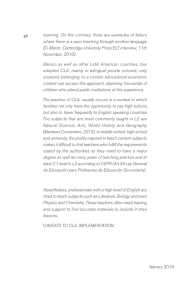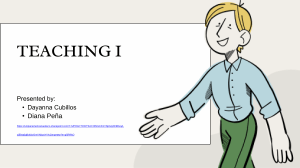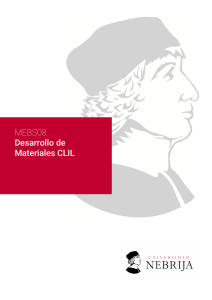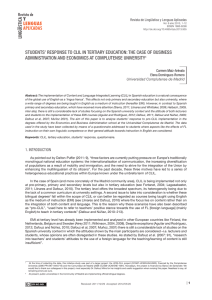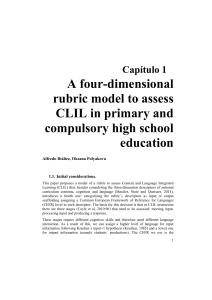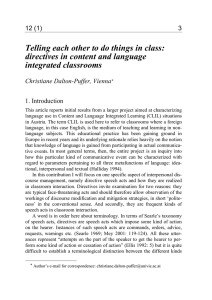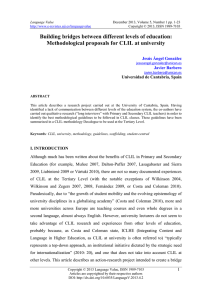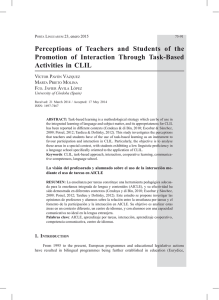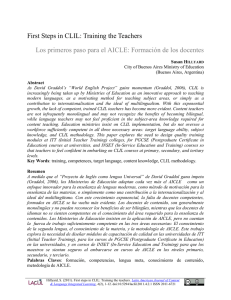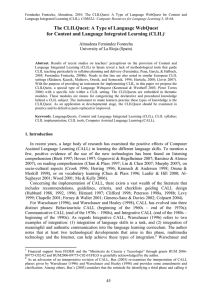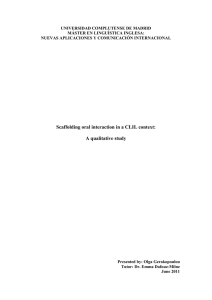THREE FRAMEWORKS FOR DEVELOPING CLIL MATERIALS IN
Anuncio
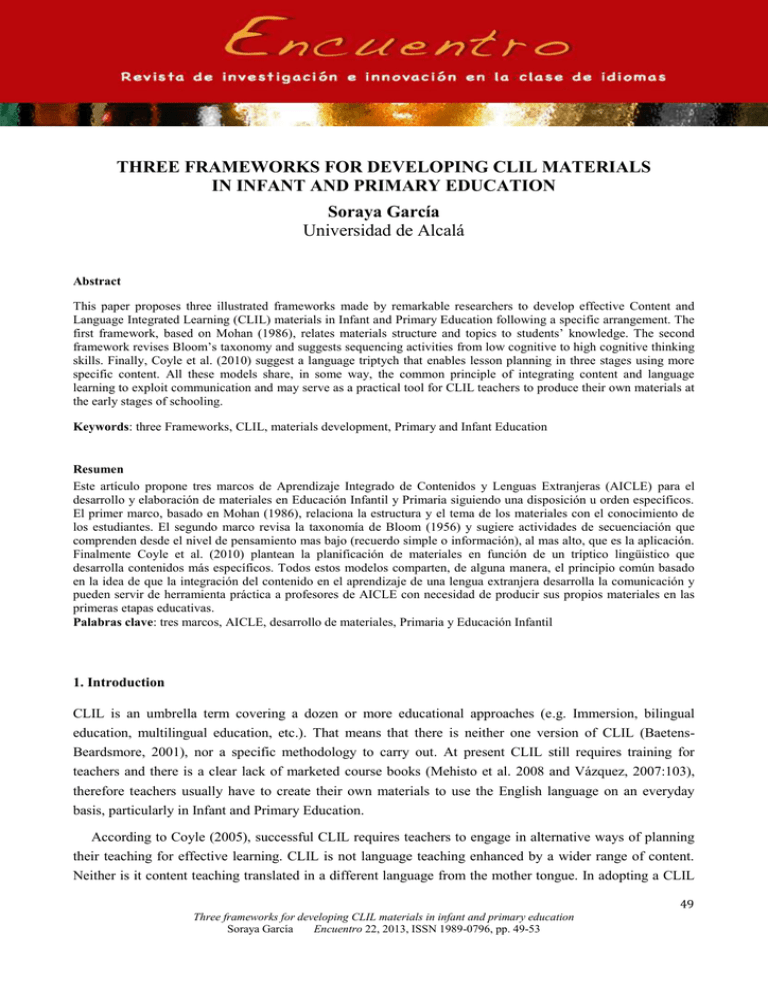
THREE FRAMEWORKS FOR DEVELOPING CLIL MATERIALS IN INFANT AND PRIMARY EDUCATION Soraya García Universidad de Alcalá Abstract This paper proposes three illustrated frameworks made by remarkable researchers to develop effective Content and Language Integrated Learning (CLIL) materials in Infant and Primary Education following a specific arrangement. The first framework, based on Mohan (1986), relates materials structure and topics to students’ knowledge. The second framework revises Bloom’s taxonomy and suggests sequencing activities from low cognitive to high cognitive thinking skills. Finally, Coyle et al. (2010) suggest a language triptych that enables lesson planning in three stages using more specific content. All these models share, in some way, the common principle of integrating content and language learning to exploit communication and may serve as a practical tool for CLIL teachers to produce their own materials at the early stages of schooling. Keywords: three Frameworks, CLIL, materials development, Primary and Infant Education Resumen Este artículo propone tres marcos de Aprendizaje Integrado de Contenidos y Lenguas Extranjeras (AICLE) para el desarrollo y elaboración de materiales en Educación Infantil y Primaria siguiendo una disposición u orden específicos. El primer marco, basado en Mohan (1986), relaciona la estructura y el tema de los materiales con el conocimiento de los estudiantes. El segundo marco revisa la taxonomía de Bloom (1956) y sugiere actividades de secuenciación que comprenden desde el nivel de pensamiento mas bajo (recuerdo simple o información), al mas alto, que es la aplicación. Finalmente Coyle et al. (2010) plantean la planificación de materiales en función de un tríptico lingüistico que desarrolla contenidos más específicos. Todos estos modelos comparten, de alguna manera, el principio común basado en la idea de que la integración del contenido en el aprendizaje de una lengua extranjera desarrolla la comunicación y pueden servir de herramienta práctica a profesores de AICLE con necesidad de producir sus propios materiales en las primeras etapas educativas. Palabras clave: tres marcos, AICLE, desarrollo de materiales, Primaria y Educación Infantil 1. Introduction CLIL is an umbrella term covering a dozen or more educational approaches (e.g. Immersion, bilingual education, multilingual education, etc.). That means that there is neither one version of CLIL (BaetensBeardsmore, 2001), nor a specific methodology to carry out. At present CLIL still requires training for teachers and there is a clear lack of marketed course books (Mehisto et al. 2008 and ue , 2007:103), therefore teachers usually have to create their own materials to use the English language on an everyday basis, particularly in Infant and Primary Education. According to Coyle (2005), successful CLIL requires teachers to engage in alternative ways of planning their teaching for effective learning. CLIL is not language teaching enhanced by a wider range of content. Neither is it content teaching translated in a different language from the mother tongue. In adopting a CLIL 49 Three frameworks for developing CLIL materials in infant and primary education Soraya García Encuentro 22, 2013, ISSN 1989-0796, pp. 49-53 approach, there will be elements of both language and subject teaching and learning which are specific to the CLIL classroom as well as emerging CLIL methodologies. Due to the nature of this flexible approach teachers can develop materials of a given course putting building blocks together in a particular order. Following Banegas (2010), this paper proposes three similar frameworks for organizing materials according to Bloom (1956), Mohan (1986) and Coyle (2005), which can help deliver effective CLIL in Infant and Primary Education. 2. An overview of CLIL in Infant and Primary Education As stated in Consejo Escolar de la Comunidad de Madrid (2010), English as a Foreign Language is started to be used as a means of instruction from the first course of Infant Education in different national bilingual programs. The main objectives of bilingual teaching are to improve the communicative competence of students, especially when referring to oral skills focusing on fluency, to learn contents from other areas using the English language, to conceive the English language as a tool of communication that is used in a normalized environment (English as the vehicular language for learning other subjects than English), and to develop themselves intellectually and emotionally. During the early stages of education the content‐subject area implies a lot of learning by doing, responding with non‐verbal communication, and TPR practices. No written support is provided until the last year of Preschool, the language of instruction is introduced orally with the help of different visual resources and materials. Several authors (Trujillo, Torrecillas y Salvadores, 2004) consider materials a central aspect in foreign language teaching and a decisive element in the relationship between teacher, learner and foreign language acquisition. For that reason teachers need to have a wide range of materials available, particularly in early schooling. Apart from traditional resources (blackboard, textbook, flashcards, puppets, etc), there are many activities implying songs, tales, etc. which can also be done with audio-visual materials such as the interactive whiteboard and internet to foster the acquisition of linguistic competence and help teachers enrich the pupils communicative skill in an entertaining and motivating way. As Coyle et al. (2010) point out, teaching CLIL involves organizing cognitively challenging materials providing effective scaffolding supported by some model-view-controller frameworks. 3. Three Frameworks for Developing CLIL Materials CLIL is flexible and there are many different models depending on a range of contextual factors that depend on the learning focus and the outcomes. The present projected frameworks and proposals for structuring materials focus on the model where English language teachers develop a more content type approach to a theme from a global and interdisciplinary perspective. 3.1. Mohan’s knowledge structures In the opinion of Mohan (1986: 35), any materials or subsequent adaptation, should start by relating their structuring topics to the learners’ lives thus encouraging elicitation to benefit from what learners know already. Teachers need to organize materials in the following order: familiar language, familiar content, new content and last new language. 50 Three frameworks for developing CLIL materials in infant and primary education Soraya García Encuentro 22, 2013, ISSN 1989-0796, pp. 49-53 For example, if the aim is to introduce holidays, we may ask learners to describe their last holidays, maybe places they have been to or different activities they have carried out. From their descriptions we can brainstorm some general ideas about this topic. Through an example of vacations, we may introduce new language by making them notice prepositions of time and/or time expressions such as in the morning, at noon, at night, etc. and specific vocabulary. Next, pupils may be asked to sequence and organize their holidays. Once they have covered this activity, they may contrast their sequencing with principled aspects of holidays such as transportation, places and activities among others. Finally, learners in groups may respond to a scenario in which holidaymakers perform a certain activity. Their decision-making will be contrasted again with a similar evaluation taken from another new context, perhaps reported in a video or animation. 3.2. A revised framework of Bloom’s taxonomy Teachers may need to sequence their activities according to the following order of cognitive processes: remembering, understanding, applying, analyzing, evaluating and creating. The categories go from low cognitive to high cognitive thinking skills. Let´s consider that our aim is to talk about folktales. First, we can ask our schoolchildren about their favorite folktales. We can discuss in groups which ones they like. To introduce new vocabulary we may show them visuals of different folktales. We may ask pupils to recap the visuals by telling me which tales they were without looking (Remember). Then we can give them a folktale chart and, based on the brief descriptions of each one, we can ask them to classify them into types: fairy tales, hero tales, fables, etc. (Understand). Imagine that now we make them notice specific terminology and the Wh- questions: What, How many, Where, When, How old, etc. used to describe each folktale featured. We may ask them to get in pairs through an information gap activity. In pairs they can complete a folktale chart with the Wh- questions (Apply). Based on that, learners watch shots from different films and organize them according to folktale subtype (Analyse). We may ask them to judge whether those folktales have got evil or good characters (Evaluate). Last, we can arrange a theatre play or storytelling in groups to present it in the following class (Create). 3.3. The CLIL Matrix Coyle et al. (2010: 43-45) take Mohan and Bloomfield above into account, but they further develop concerns about cognitive challenge accompanied by language support. They move from building students’ confidence dealing with the content and language they know in groups or more interactive tasks, to individual tasks and further demands in terms of language and content. They organize language activities in a Language Triptych so that materials should expose learners to: a) language of learning, that is, the learning of key words and phrases to access content, b) language for learning focusing on the language students will need to carry out classroom tasks such as explaining, and c) language through learning to make room for unpredictable language learning that may arise as the lesson unfolds. For example, if our aim is to plan a lesson about eating healthy we can start by resorting to familiar language such as simple present asking learners: ‘Which food is healthy?´. From the answers we can elicit familiar knowledge such as food types (vegetables, fruit, etc.). Through more oral examples or songs taken from Internet we can introduce them a food pyramid. We may introduce different structures such as adj. + 51 Three frameworks for developing CLIL materials in infant and primary education Soraya García Encuentro 22, 2013, ISSN 1989-0796, pp. 49-53 noun combinations, countable and uncountable nouns or quantifiers (some / a lot of, etc.) by recapping the factors mentioned, and completing sentences so that they use the forms and functions. Pupils can then, in small groups, present and retell food types in a poster in which they evaluate which food is healthy. 4. Discussion According to Banegas (2010), in Mohan´s framework it is interesting to see how learning is built up stage by stage from the particular to the more general allowing learners to apply reasoning thinking to arrive at more general conclusions that will be subsequently used to assess other situations. Whereas Mohan´s and Bloom´s frameworks provide a useful guide for the overall design of a unit of work, Coyle´s et al. CLIL matrix can be used for a more detailed lesson planning as they operate in three stages to be used with more specific content. Coyle´s relationship between language and cognition (thinking and understanding) is complex, effective learning involves however cognitive challenge and feedback. Most of the activities imply from a low cognitive domain to a high linguistic domain. Scaffolding can be provided in language boxes, mind frames as well as teacher support. Teachers can use different conceptual, material and linguistic tools and technologies to support learning. Each framework can feature different activities to work the contents in two or more consecutive lessons: from dances to storytelling, and can be presented orally or visually with books, media support (CD, DVD, Interactive Whiteboard, etc.), realia, original stories, songs or films from English speaking writers (Eric Carle, David McKee, etc.). There can be written and oral activities, but it is crucial to give special relevance to those activities where a discussion is started. At these stages maintaining a conversation or a discussion in the foreign language can be a complex task, thus the main purpose is to make children be in touch with the language in a natural way, focusing on the general meaning of what we are saying and assuring that they have a general comprehension that guarantees a global understanding of the concepts worked through. Written activities, should be an extension of the oral ones. Taking into account the idea of interrelation that features CLIL, the proposed frameworks imply teachers creating materials for Infant and Primary school children leaving apart the point of view of a specialist teacher (English teacher/ Primary teacher/ Science teacher/ etc.). 5. Conclusion There is no single model for CLIL. Different models share the common founding principle that in some way content and language learning are integrated. CLIL assumes that subject teachers are able to exploit materials and opportunities for language learning and draws on the communicative approach. By carrying out the suggested frameworks learners will have the chance to develop their linguistic and cognitive skills when they build up and explain their experiences, ideas, tasks etc. Due to the lack of CLIL course books, training or a specific methodology in Infant and Primary Education, teachers need to produce their own materials in order to make them truly CLIL contextresponsive. Teachers can follow principles published elsewhere and some of the frameworks reviewed in this article, however, whatever kind of model, it is fundamental that the content of the topic is present all the time and is considered the starting point of the planning and material creation process. 52 Three frameworks for developing CLIL materials in infant and primary education Soraya García Encuentro 22, 2013, ISSN 1989-0796, pp. 49-53 References Banegas, D. (2010). Three Frameworks for Developing CLIL Materials. Folio 13/1: 12-14. Baetens-Beardsmore, H. (2001). Foreword: The past decade and the next millennium. In Profiling European CLIL classrooms, ed. D. Marsh, A. Maljers, and A. Hartiala, 101. Finland: University of Jyvaskyla; The Netherlands: European Platform for DutchEducation. Bloom B. S. (1956). Taxonomy of Educational Objectives, Handbook I: The Cognitive Domain. New York: David McKay. Consejo Escolar de la Comunidad de Madrid. (2010). Los Programas de Enseñanza Bilingüe en la Comunidad de Madrid. Un estudio comparado. Madrid: Publicaciones de la Conserjería de Educación. Coyle, D. (2005). Developing CLIL: Towards a Theory of Practice, in APAC Monograph 6, APAC: Barcelona. Coyle, D.; Hood, P. & Marsh, D. (2010). CLIL. Content and Language Integrated Learning. Cambridge: Cambridge University Press. Mehisto, P., Marsh, D., Frigols, M.J. (2008). Uncovering CLIL: Content and Language Integrated Learning in Bilingual and Multilingual Education. Oxford: Macmillan. Mohan, B. (1986). Language and Content. Reading. MA: Addison-Wesley. Trujillo, C. Torrecillas, D. y Salvadores. D. (2004). TEFL in Primary Education in Madrid and Neil McLaren (eds.). Granada: Editorial de la Universidad de Granada, pp. 409-441. ue , G. (2007). ”Models of CLIL: An evaluation of its status drawing on the German experience”, in A critical report on the limits of reality and perspectives. evista espa ola de ling stica aplicada 1:95-111. Available at <http://dialnet.unirioja.es/servlet/articulo?codigo=2575498> (Date accessed 2 December, 2013). Soraya Garcia has a PhD in Modern Languages, Literature and Translation and a MA from the University of the West of England. She is a lecturer of undergraduate and postgraduate levels at Universidad de Alcalá, a Teacher trainer at C.U Cardinal Cisneros and is involved in various research projects in the area of lexicography, integrating technology in education and microteaching practice in Infant and Primary Education. Her areas of interest are ESP, CLIL and developing language skills with technology. 53 Three frameworks for developing CLIL materials in infant and primary education Soraya García Encuentro 22, 2013, ISSN 1989-0796, pp. 49-53
